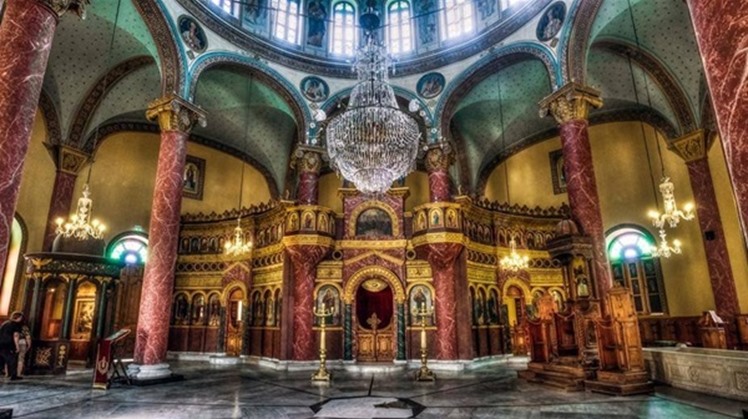The days are approaching for the Western churches to celebrate Christmas on December 25, and the Egyptian Church on January 7, and the Interfaith Complex in Old Cairo is awaiting visits from Egyptians and foreigners to celebrate Christmas as an exceptional global value. The Church of the Nativity, and the Old Cairo area is distinguished by the cave of the Abu Sarga Church, which the Holy Family sought refuge in in Egypt and remained there for a period during their arrival from Palestine and upon their return
Researcher Dr. Abdel Rahim Rihan, Director General of Research, Archaeological Studies and Scientific Publishing in South Sinai at the Ministry of Tourism and Antiquities, explains that the cave, since the establishment of the Abu Serga Church, has been the focus of local and international attention. Some even called it “the cave church” and this church is also distinguished by the presence of an ancient water well. Jesus drank from it. Currently, the opening is a glass door through which visitors can look into the well. The cave is divided into three spaces separated by stone pillars, 6 meters long and 4.5 meters wide, and the cave is lower than the church’s roof by at least 6 meters.
The Church of Abu Sarja, or “Saints Sergius and Bacchus,” who were killed in Rusafa in Iraq because of their conversion to Christianity during the period of the Roman Emperor Maximanos, was dedicated. The church was established over the ruins of an ancient Roman castle. Some scholars believe that it dates back to the late fourth or early fifth century AD. Others say that it dates back to the seventh century AD, and this church enjoys a special status because of its connection to the Holy Family's journey in Egypt and the presence of the cave.
Dr. Rihan monitors the architectural and artistic features of the panorama of the monasteries of nuns in the ancient Egypt region through a study by Dr. Shorouk Ashour, head of the Tourist Guidance Department at the Future Academy, which took its fame from its presence in the place where the three religions gather in one crucible, where the Temple of Ibn Ezra and the cave remaining in the Abu Serga Church is the place of refuge. The Holy Family when they fled to Egypt and the second oldest mosque in Egypt, the Amr Ibn Al-Aas Mosque.
Dr. Abdel Rahim Rayhan presents the features of this study, which shed light on the monastery of the martyr Abu Sefein, which was built after the fifth century AD, and whose main facade and its large entrance overlook the Helwan Metro railway. The railway extends to the end of the monastery wall and then bends at a right angle to Jamea Amr Street. This bend has an entrance that leads to the churches surrounding the monastery, namely the Church of Anba Shenouda and the Virgin of Damascus and the great Abu Sefein Church.
"Rehan" adds that the great Abu Sefein Church was the main church of the monastery, in which all prayers and masses take place, and monastic ordination ceremonies take place. Therefore, the nuns had a special door that opened from the monastery directly onto the church, where there was a place designated for them. This door is located on the western side in front of the entrance to the church Abi Seifin so far. As for the Church of St. Demiana, the first mass was held in it on January 21, 1980, the feast of the martyrdom of St. Demiana, corresponding to the 13th of Tuba. The Church of St. Joseph was registered in the name of Youssef Al-Najjar and was established inside the new monastery and has not been inaugurated yet. It is for nuns only, without visitors to the monastery like it Like the Church of the Archangel Michael
Dr. Rihan refers to the painting of the Holy Family’s Escape to Egypt in the monastery of Abu Sefein, which was at the entrance to the monastery, but after the development process of the monastery, it was removed as a plaster layer and was returned again to the left from the entrance door to the Church of the Virgin, a large painting representing the Virgin Mary carrying Jesus They are riding a donkey, behind them stands Youssef Al-Najjar, and from above there is an angel with two wings, and below this angel are three pyramids.
The area includes the Saint George Monastery, which enters it from a neighborhood known by this name because there are more than one monument bearing the name of the martyr. The Church of the Virgin (Qasr al-Rayhan) is also known as the Church of St. George, and access to this neighborhood is by a staircase descending from the Coptic Museum Street
Dr. Rihan pointed out that the study was exposed to the dress of nuns and monks, and the nuns’ clothes are the same as the monks’ clothes, but the veil is added to distinguish the nuns and distinguishes the monk from the nun in the clothing of the skin of the skin. The monks’ robe is represented in the galabiya known as the columbium, which means short in Coptic, then the cap, which is the head covering and ends with a veil that hangs over the shoulder to cover the neck. The monk does manual labor.
And from the clothing of the region, the leather, which is a strip of leather on which three crosses are drawn, and it is exactly like the belt, but it is wider and reaches 5 cm in width. The earth, its temperature, and the stick, which is a palm leaf that the monk used to carry during his travels, and the veil. It is also known as the (talmatmah), which distinguishes the nuns’ wearing without the monks, and it is often made of cheap types of cloth and the same color as the black robe.
 Thu, Dec. 23, 2021
Thu, Dec. 23, 2021